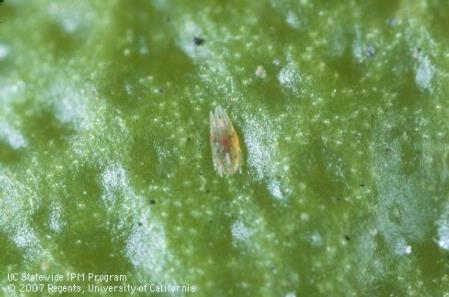Brevipalpus mite species belong to a larger group or family of mites the Tenuipalpidae, referred to as flat mites. The genus Brevipalpus is considered the most important one in the family. The mites are small ranging in size from 200-400 micrometers in length, flattened and frequently red in color. They have been under increasing investigation because of their potential as plant pests and their involvement with vectoring plant viruses. The three most important species are B.californicus(Banks), B.obovatus(Donnadieu), and B.phoenicis(Geijskes). All three species occur on citrus as well as many other host plants in the same areas worldwide. A fourth species B.lewisi (McGregor) is found in more arid climates. B.phoenicis is a pest of citrus, coffee, tea and passionfruit and numerous ornamental plants. B.californicus is a pest on orchids. B.lewisi is a pest on citrus, grapes, pistachio, walnuts and pomegranate. It has never been assessed as a possible vector of citrus leprosis or other related viruses.
Typically, Brevipalpus mite development consists of a larval, protonymph, deutonymph and adult stage. The rate of development is strongly influenced by temperature, relative humidity and host plant. In developmental studies at eighty degrees Fahrenheit (F), development of B.obovatus was completed in 13 days with adult females living 40 days and depositing 50 eggs per female. In comparison, development of B.lewisi at 90 degrees and 35% relative humidity was completed in 17 days. Egg laying varied from six eggs per female per day at 90 degrees to 18 eggs per day at 80 degrees. Eggs were deposited in cracks or crevices on fruit surfaces.
Tenuipalpid mites inject toxic saliva into fruit, leaf, stem and bud tissues of citrus and other host plants. B.lewisi causes a russeting and cracking of the rind on pomegranate fruit, with damage first observed near the stem end. B.californicus feeding has been associated with severe stunting of citrus seedlings in Texas and corky swollen buds in Texas, Florida and Venezuela, a condition referred to as Brevipalpus gall. B.phoenicis has been associated with a fungal pathogen, Elsinoe fawcetti resulting in defoliation and death of citrus seedlings. Feeding damage by Brevipalpus mites on citrus in Texas is most prevalent on inside fruit in the lower tree canopy. Fruit lesions first appear as very slight yellowish circular areas in depressions on the fruit surfaces. These lesions gradually develop a central brown necrotic area and gradually become darker and corky in texture. The extent of this damage varies depending upon mite infestations and can cover half of the fruit surface. On some orange selections in Texas, lesions resulting from mite feeding have been referred to as leprosis-like spotting or nail-head rust, appearing as brownish blemishes on fruit particularly on the stylar end and on fruit in the inner canopy. Brevipalpus mites prefer damaged areas on citrus fruit or where depressions occur on the fruit surface; the mites tend to aggregate in these areas and lay their eggs. Brevipalpus lewisi and B.californicus feed primarily on citrus fruit. In Califonia, feeding injury by B.lewisi on citrus fruit results in scab-like isolated depressions. B.lewisi feeding in California pistachios results in dark, irregular and roughened scab-like blotches. In one observation in 2002 near Bakersfield, B.lewisi was readily found on the fruit in the outer canopy of Valencia trees with temperatures of 95-100 F and low relative humidity.
The most significant threat created by the three Brevipalpus mite species, B.californicus, B.obovatus, and B.phoenicis, is their involvement in vectoring a group of plant viruses. They have been identified from citrus in Brazil, Costa Rica, Honduras, South Africa, Florida and Texas B.phoenicis is recognized as the vector of citrus leprosis in Brazil, coffee ringspot virus, passionfruit green spot and various viruses of ornamental plants. In Argentina and Venezuela citrus leprosis was reportedly vectored by B.obovatus. B.californicus was the reported vector of leprosis in Florida.
Confusion has existed for decades concerning the differences between feeding injuries caused by Brevipalpus mites and leprosis virus infection on citrus. [The only accurate method for determination of infection by citrus leprosis virus is using transmission electron microscopy] [no longer true….there is a molecular method now available to identify presence of leprosis virus] to verify presence of virus particles or viral inclusion bodies. The abililty to correctly identify and separate Brevipalpus mite feeding injuries, citrus leprosis virus infections, and unrelated but similar maladies on citrus are essential for citrus producers, shippers and regulatory personnel involved in international movement of fruits and plants.
*Brevipalpus californicus, B.obovatus, B.phoenicis, and B.lewisi(Acari:Tenuipalpidae): a review of their biology, feeding injury and economic importance. Carl C. Childers, J. Victor French and Jose Carlos V. Rodrigues.
